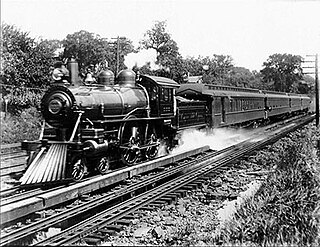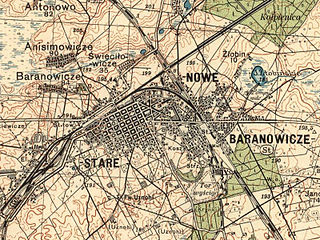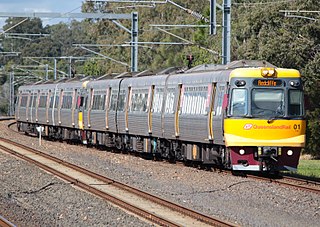
Transportation engineering or transport engineering is the application of technology and scientific principles to the planning, functional design, operation and management of facilities for any mode of transportation in order to provide for the safe, efficient, rapid, comfortable, convenient, economical, and environmentally compatible movement of people and goods transport.

Railway signalling is a system used to direct railway traffic and keep trains clear of each other at all times. Trains move on fixed rails, making them uniquely susceptible to collision. This susceptibility is exacerbated by the enormous weight and inertia of a train, which makes it difficult to quickly stop when encountering an obstacle. In the UK, the Regulation of Railways Act 1889 introduced a series of requirements on matters such as the implementation of interlocked block signalling and other safety measures as a direct result of the Armagh rail disaster in that year.

In railroad structures, and rail terminology, a wye or triangular junction is a triangular joining arrangement of three rail lines with a railroad switch at each corner connecting to each incoming line. A turning wye is a specific case.

A track pan or water trough is a device to enable a steam railway locomotive to replenish its water supply while in motion. It consists of a long trough filled with water, lying between the rails. When a steam locomotive passes over the trough, a water scoop can be lowered, and the speed of forward motion forces water into the scoop, up the scoop pipe and into the tanks or locomotive tender.

The Wassaic station is a commuter rail stop on the Metro-North Railroad's Harlem Line, located in Wassaic, New York. It is the northern terminal of the Harlem Line. Trains leave for New York City every two hours, and about every 30 minutes during rush hour. It is 82 miles (132 km) from Grand Central Terminal and travel time to Grand Central is approximately two hours, eleven minutes.

A junction, in the context of rail transport, is a place at which two or more rail routes converge or diverge. This implies a physical connection between the tracks of the two routes, provided by points and signalling. Junctions are important for rail systems, their installation into a rail system can reduce route capacity, and have a powerful impact upon on-time performance.

Centralized traffic control (CTC) is a form of railway signalling that originated in North America. CTC consolidates train routing decisions that were previously carried out by local signal operators or the train crews themselves. The system consists of a centralized train dispatcher's office that controls railroad interlockings and traffic flows in portions of the rail system designated as CTC territory. One hallmark of CTC is a control panel with a graphical depiction of the railroad. On this panel, the dispatcher can keep track of trains' locations across the territory that the dispatcher controls. Larger railroads may have multiple dispatcher's offices and even multiple dispatchers for each operating division. These offices are usually located near the busiest yards or stations, and their operational qualities can be compared to air traffic towers.

New York City Subway chaining is a method to precisely specify locations along the New York City Subway lines. It measures distances from a fixed point, called chaining zero, following the twists and turns of the railroad line, so that the distance described is understood to be the "railroad distance," not the distance by the most direct route.
Railroad directions are used to describe train directions on rail systems. The terms used may be derived from such sources as compass directions, altitude directions, or other directions. However, the railroad directions frequently vary from the actual directions, so that, for example, a "northbound" train may really be headed west over some segments of its trip, or a train going "down" may actually be increasing its elevation. Railroad directions are often specific to system, country, or region.

A double-track railway usually involves running one track in each direction, compared to a single-track railway where trains in both directions share the same track.

A passing loop or passing siding is a place on a single line railway or tramway, often located at a station, where trains or trams travelling in opposite directions can pass each other. Trains/trams going in the same direction can also overtake, provided that the signalling arrangement allows it. A passing loop is double-ended and connected to the main track at both ends, though a dead end siding known as a refuge siding, which is much less convenient, can be used. A similar arrangement is used on the gauntlet track of cable railways and funiculars, and in passing places on single-track roads.

Train order operation, or more accurately timetable and train order operation, is a largely obsolete system by which the railroads of North America conveyed operating instructions before the days of centralized traffic control, direct traffic control, and the use of track warrants conveyed by radio. The system used a set of rules when direct communication between train dispatchers and trains was limited or non-existent. Trains would follow a predetermined operating plan, known as the timetable, unless superseded by train orders conveyed to the train from the dispatcher, through local intermediaries. Train order operation was a system that required minimum human overhead in an era before widespread use of technology-based automation. It was the most practical way for railroads with limited capital resources, or lines with limited traffic, to operate. To this day, a large number of short lines, heritage railways, and railroad museums continue to use Train Order operation.

A single-track railway is a railway where trains traveling in both directions share the same track. Single track is usually found on lesser-used rail lines, often branch lines, where the level of traffic is not high enough to justify the cost of constructing a second track.

A level junction is a railway junction that has a track configuration in which merging or crossing railroad lines provide track connections with each other that require trains to cross over in front of opposing traffic at grade.

The Danbury station is a commuter rail stop on the Danbury Branch of the Metro-North Railroad's New Haven Line, located in Danbury, Connecticut. The station is the northern terminus of Danbury Branch. Since the Danbury Branch is mostly single-tracked, most service is a shuttle to South Norwalk with three peak-hour runs to Grand Central; service to South Norwalk takes approximately 47 minutes, service to Grand Central 1 hour, 55 minutes. The station is 64.9 miles (104.4 km) to Grand Central; it is adjacent to both the Danbury Railway Museum and the hub for Housatonic Area Regional Transit. The station has 147 parking spaces, all owned by the state.
Standards for North American railway signaling in the United States are issued by the Association of American Railroads (AAR), which is a trade association of the railroads of Canada, the USA, and Mexico. Their system is loosely based on practices developed in the United Kingdom during the early years of railway development. However, North American practice diverged from that of the United Kingdom due to different operating conditions and economic factors between the two regions. In Canada, the Canadian Rail Operating Rules (CROR) are approved by the Minister of Transport under the authority of the Railway Safety Act. Each railway company or transit authority in Canada issues its own CROR rulebook with special instructions peculiar to each individual property. Among the distinctions are:

The Naugatuck station is a commuter rail stop on the Waterbury Branch of the Metro-North Railroad's New Haven Line, located in Naugatuck, Connecticut, United States. All service on the Waterbury Branch is shuttle service to Bridgeport running on very light frequencies ; travel time to Bridgeport is 43 minutes.

Positive train control (PTC) is a system of functional requirements for monitoring and controlling train movements and is a type of train protection system. The term stems from control engineering. The train is only allowed to move in case of positive movement allowance. It generally improves the safety of railway traffic.

Automatic block signaling (ABS) is a railroad communications system that consists of a series of signals that divide a railway line into a series of sections, or "blocks". The system controls the movement of trains between the blocks using automatic signals. ABS operation is designed to allow trains operating in the same direction to follow each other in a safe manner without risk of rear-end collision. The introduction of ABS reduced railways' costs and increased their capacity. Older manual block systems required human operators. The automatic operation comes from the system's ability to detect whether blocks are occupied or otherwise obstructed, and to convey that information to approaching trains. The system operates without any outside intervention, unlike more modern traffic control systems that require external control to establish a flow of traffic.
The Nashville Terminal Subdivision is a railroad line owned by CSX Transportation in the U.S. State of Tennessee. The Subdivision is broken up into 5 sections all in Nashville, Tennessee.


















